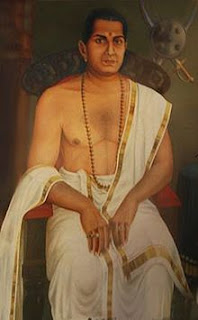 |
| Tomb of pazhassi Raja -kudeeramarchaeology.kerala.gov.in |
Hailing from the Kottayam (North Malabar) Royal family, Kerala Varma Pazhassi Raja was not only a great administrator of his kingdom but also a great tactical warrior. At Mananthavadi the tomb of this distinguished warrior warrior lies and now it a protected monument of great historical value being managed by the Department of Archaeology, Kerala state. Located on the banks of River Kabani the tomb was built in the place where Pazhassi Raja was created. He got the appellation ''Lion of Kerala'' for his guts, valor and indomitable fighting qualities.
His exploits against the corrupt and cunning East India company's army are quite well-known when they were bent on controlling parts of Kerala.
In memory of this great personality a museum came up near this place. For the lovers of art and historians, it is a heaven because on display in the Pazhassi Raja Museum & Art Gallery close to the museum are popular and well-acclaimed oil paintings of Kerala's greatest artist Raja Ravi Varma (1848 - 1906), besides Pazhassi Raja's sword and other information about the cultural history of Kerala. The memorial is managed by the Kerala State Archaeology Department.
 |
| Pazhassi Raja, Kerala en.wikipedia.org |
Very few Indians across the country know about the patriotic zeal of Pazhassi Raja, who has the distention being one among a few Indian rulers of the sub-continent ever to score a military victory over the British. He diligently tackled the foreign invader, then a force to reckon with in 1793.
Kottayam, a small chiefdom was a branch of the Chirakkal Raja's of North Malabar in the second half of the 18th century. During raid from Tipu Sultan of Mysore and his powerful army, the Kottayam Raja took refuge in the kingdom of Travancore the Pazhassi Raja never failed to offer his timely help. He organized stiff resistance against the invading armies with the assistance of the English East India Company. In 1790, under Colonel Hartley a British army of 2,000 men camped in South Malabar to fight against Mysore army of 9,000 Sepoys and 4,000 Moplays. Ravi Varma sent the additional reinforcement of 5,000 Nairs warriors to aid the English company and his timely interference helped the British win the Third Anglo-Mysore War.
 |
| Tomb of pazhassi RajaMananthavady.keralatourism.org |
The Thirurahgadi battle was a famous one. After 1792, the termination of the third Anglo-Mysore war, the Malabar Rajas including Kottayam came under the British authority. Later, the claims of the Kottayam Raja was overlooked by the East India Company and they affected a revenue agreement with the Raja of Kurumbranadu. The british imposed heavy taxes on the farmers and land owners. That the British never restored Calicut and other places to Ravi Varma as a precondition for his help to the British in their battle against Tipu. Quite was a breach of trust, Pazhassi Raja, in rage, revolted against the English company.
In the famous 'Pazhassi Revolt against the British company in the second half of the 1700s Pazhassi Raja strategically used guerrilla warfare in the hills of Wayanad to resist the increasingly intolerable and menacing British colonists who had better artillery power artillery power. The hill tribes gave stiff resistance to the English and several European officers lost their lives in this battle.
After the fall of Tipu Sultan the British imposed martial laws in the areas controlled by Pazhassi Raja, In his long drawn struggle against the English company and their attempt to take over part of Kerala during a skirmish he was shot dead on 30 November 1805 in action at Mavilathode near Pulpalli.
Col. Richard Wellesley of EIC whose troops was responsible for the death of Tipu Sultan upon their successful entry into the fort at Srirangapatna through the Cauvery gate could not overcome Pazhassi Raja, a ruler of a small kingdom. Col Wellesley's strategies against him met in failure. However, the same English officer when he led the army against Napoleon Bonaparte (18 June 1815) in Waterloo (now in Belgiam), he came out victorious and won laurels; later he came to be called Duke Wellington.
It is quite befitting the museum and art galley is named after Pazhassi Raja, a great freedom fighter who had spent much of his time relentlessly fighting against two Mysore Muslim rulers and later the invader from Europe. This interesting museum is in East Hill, a serene, picturesque place about 5 km from the Kozhikode town.
He is still remembered for his love and undying loyalty towards his subjects till the very end. The Pulpally Cave was where Pazhassi took refuge until he was captured by the British.
Nearest railway station: Vadakara, about 51 km and Kozhikode, about 66 km away. Nearest airport: Kannur International Airport, about 65 km | Calicut International Airport, about 115 km
https://www.keralatourism.org/destination/pazhassi-tomb-wayanad/212
https://en.wikipedia.org/wiki/Ravi_Varma_of_Padinjare_Kovilakam
https://www.keralatourism.org/destination/pazhassiraja-museum-art-gallery-kozhikode/258







.webp)

